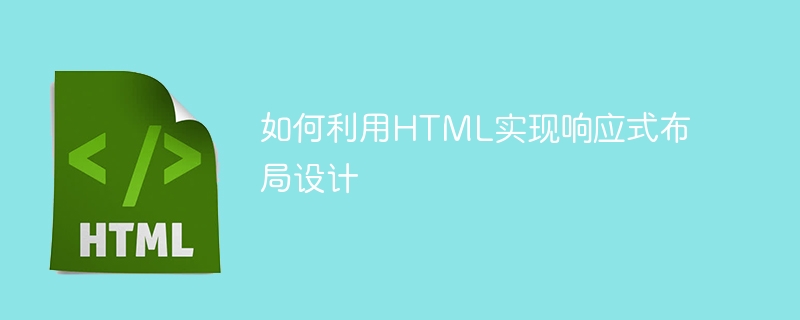Implementation method of HTML's responsive layout design guide

How to use HTML to implement responsive layout design
With the popularity of mobile devices and the rapid development of the Internet, responsive layout has become an essential skill for designers. Responsive layout allows the website to automatically adapt to different screen sizes and resolutions on different devices, allowing users to have a better browsing experience. This article will introduce how to use HTML to implement responsive layout design and provide specific code examples.
- Using @media query
@media query is a feature in CSS3 that can apply different styles according to different media conditions. By using @media queries, we can adjust the layout according to the width of the screen.
For example, we can set different styles for devices with screen widths less than 600px:
@media screen and (max-width: 600px) {
/* 在这里设置你想要的样式 */
}In this style block, you can set the layout and style for a specific screen width. You can use some CSS properties, such as display, float, width, etc., to adjust the layout.
- Using CSS Grid Layout
CSS grid layout is a function provided by CSS3, which can help us implement responsive layout more conveniently. Grid layout divides the page into multiple grids of different sizes and then places elements into these grids. By adjusting the size and position of the grid, we can achieve layouts for different screen sizes.
The following is an example of using CSS grid layout:
<div class="grid-container">
<div class="item">Item 1</div>
<div class="item">Item 2</div>
<div class="item">Item 3</div>
</div>
<style>
.grid-container {
display: grid;
grid-template-columns: repeat(auto-fit, minmax(200px, 1fr));
grid-gap: 10px;
}
.item {
background-color: #ccc;
padding: 10px;
}
</style>In this example, we divide a container containing three items into a grid layout and set up auto-fit columns Number of attributes grid-template-columns. Each item is styled identically.
- Using Flexbox Layout
Flexbox layout is another feature provided by CSS3, which is also very suitable for implementing responsive layout. Flexbox layout can easily adjust the size and position of elements and automatically adapt to different screen sizes.
The following is an example of using Flexbox layout:
<div class="flex-container">
<div class="item">Item 1</div>
<div class="item">Item 2</div>
<div class="item">Item 3</div>
</div>
<style>
.flex-container {
display: flex;
flex-wrap: wrap;
justify-content: space-between;
}
.item {
background-color: #ccc;
padding: 10px;
flex-basis: calc(33.33% - 20px);
}
</style>In this example, we set a container containing three items to the Flexbox layout and set equal-width styles for the items .
Summary:
By using @media query, CSS grid layout and Flexbox layout, we can achieve responsive layout design. These technologies allow us to adapt layout and styling to different screen sizes and resolutions. Hopefully the code examples provided in this article can help you better understand and apply these techniques to design better responsive websites.
The above is the detailed content of Implementation method of HTML's responsive layout design guide. For more information, please follow other related articles on the PHP Chinese website!

Hot AI Tools

Undresser.AI Undress
AI-powered app for creating realistic nude photos

AI Clothes Remover
Online AI tool for removing clothes from photos.

Undress AI Tool
Undress images for free

Clothoff.io
AI clothes remover

AI Hentai Generator
Generate AI Hentai for free.

Hot Article

Hot Tools

Notepad++7.3.1
Easy-to-use and free code editor

SublimeText3 Chinese version
Chinese version, very easy to use

Zend Studio 13.0.1
Powerful PHP integrated development environment

Dreamweaver CS6
Visual web development tools

SublimeText3 Mac version
God-level code editing software (SublimeText3)

Hot Topics
 1377
1377
 52
52
 Table Border in HTML
Sep 04, 2024 pm 04:49 PM
Table Border in HTML
Sep 04, 2024 pm 04:49 PM
Guide to Table Border in HTML. Here we discuss multiple ways for defining table-border with examples of the Table Border in HTML.
 HTML margin-left
Sep 04, 2024 pm 04:48 PM
HTML margin-left
Sep 04, 2024 pm 04:48 PM
Guide to HTML margin-left. Here we discuss a brief overview on HTML margin-left and its Examples along with its Code Implementation.
 Nested Table in HTML
Sep 04, 2024 pm 04:49 PM
Nested Table in HTML
Sep 04, 2024 pm 04:49 PM
This is a guide to Nested Table in HTML. Here we discuss how to create a table within the table along with the respective examples.
 HTML Table Layout
Sep 04, 2024 pm 04:54 PM
HTML Table Layout
Sep 04, 2024 pm 04:54 PM
Guide to HTML Table Layout. Here we discuss the Values of HTML Table Layout along with the examples and outputs n detail.
 HTML Input Placeholder
Sep 04, 2024 pm 04:54 PM
HTML Input Placeholder
Sep 04, 2024 pm 04:54 PM
Guide to HTML Input Placeholder. Here we discuss the Examples of HTML Input Placeholder along with the codes and outputs.
 HTML Ordered List
Sep 04, 2024 pm 04:43 PM
HTML Ordered List
Sep 04, 2024 pm 04:43 PM
Guide to the HTML Ordered List. Here we also discuss introduction of HTML Ordered list and types along with their example respectively
 Moving Text in HTML
Sep 04, 2024 pm 04:45 PM
Moving Text in HTML
Sep 04, 2024 pm 04:45 PM
Guide to Moving Text in HTML. Here we discuss an introduction, how marquee tag work with syntax and examples to implement.
 HTML onclick Button
Sep 04, 2024 pm 04:49 PM
HTML onclick Button
Sep 04, 2024 pm 04:49 PM
Guide to HTML onclick Button. Here we discuss their introduction, working, examples and onclick Event in various events respectively.




